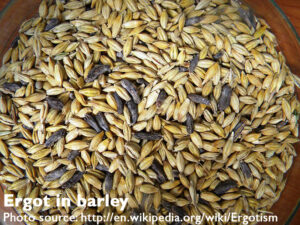Be on the Lookout for Ergot
This guest post written by Sherri Roberts, Regional Crops Specialist – Weyburn, SK. To learn more about ergot, see the links below.
Three things are needed in order for a disease to occur:
- a susceptible host,
- a disease causing organism and
- the right environment.
Saskatchewan fall rye varieties are all rated as moderately susceptible to ergot. While rye is the principal host; barley, wheat, triticale, oats and numerous species of cultivated and wild grasses are also susceptible.
The ergot causing fungal organism, Claviceps purpurea, has the ability to overwinter and remain viable for up to two years in the soil in the form of ergots or sclerotia bodies. In some areas, populations of overwintered sclerotia, have built up and provide the disease causing organism source. Sclerotia germinate in the spring just prior to flowering in cereals and grasses once they have been exposed to a minimal cold period of 4-8 weeks and after they have been exposed to moisture. Germinating sclerotia produce ascospores that are ejected into the air and are disseminated by air currents. If these floating ascospores land on a cereal head that is flowering, the ovary becomes infected and instead of forming a seed head of grain, a sclerotia body will form. A secondary infection occurs during the formation of the sclerotia that creates a substance called honeydew. This honeydew is also a source of disease spread as insects, wind and rain can transfer it to uninfected plants.
Over the past few weeks, Mother Nature has provided us with the rain and cool conditions which have created the environment for ergot infections to occur. These cool, wet conditions have also increased flowering periods in cereals and made them more susceptible to infection.
While ergot can cause a 5-10% yield reduction, the main concern should be in regards to the toxic alkaloids that are present in the ergot bodies. The Canadian Grain Commission has established limits for allowable ergot contamination. If using ergot contaminated grain for livestock feed, be aware that animals differ in their toxicity levels. Haying ergot contaminated grasses does not lower the dangers and if in doubt, have your forage sampled.
As ergot-infected wild grasses, particularly in fence rows, can be the primary inoculum in cereal and grass seed production fields, mowing headlands can be a defense mechanism to reducing this disease. Planting cereal varieties with short flowering periods along with choosing resistant varieties can also reduce your ergot susceptibility. Lengthening crop rotations so any ergot bodies that may be present in the soil are robbed of a susceptible host can also prove to be effective.
Learn More
- Ergot: Low Levels Cause Big Problems (BCRC Blog, July 31, 2014)
- Ergot Spotted in Western Canada – keep an eye out (BCRC Blog, September 23, 2013)
Click here to subscribe to the BCRC Blog and receive email notifications when new content is posted.
The sharing or reprinting of BCRC Blog articles is welcome and encouraged. Please provide acknowledgement to the Beef Cattle Research Council, list the website address, www.BeefResearch.ca, and let us know you chose to share the article by emailing us at info@beefresearch.ca.
We welcome your questions, comments and suggestions. Contact us directly or generate public discussion by posting your thoughts below.
